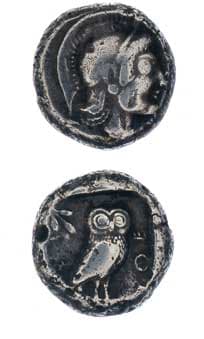Attic Silver Tetradrachm, 500 BCE
Silver
0.875 , 17.1 Grams
C.2045
Obverse, helmeted head of Athena right; reverse, ?T?, right; Owl standing on olive branch, centre; olive-sprig, top-left. The tetradrachm – a silver coin equivalent to four drachmae – first came...
Obverse, helmeted head of Athena right; reverse, ?T?, right; Owl standing on olive branch, centre; olive-sprig, top-left. The tetradrachm – a silver coin equivalent to four drachmae – first came into circulation in Athens toward the end of the sixth century BC. It became the most authoritative coinage of Classical Greece and was soon adopted by many other city-states of ancient Greece.
Silver mines discovered within the Athenian state during early fifth century BC provided the bullion. The revenue, according to Herodotus was used to build two-hundred war ships that would go on to secure victory over the Achaemenid Persians and secure mainland Greece from Persian invasion. Athens became the leading naval power in the ancient world. This mint, a first issue, shows the head of Athena, patron of Athens, wearing crested Athenian helmet. The reverse features an owl, the iconographic symbol of the Athenian polis; an olive-sprig is customarily seen in the field. According to the ancient sources, this type of coinage was vernacularly known as “little owl” and would remain scarce changed over the following two centuries.
Silver mines discovered within the Athenian state during early fifth century BC provided the bullion. The revenue, according to Herodotus was used to build two-hundred war ships that would go on to secure victory over the Achaemenid Persians and secure mainland Greece from Persian invasion. Athens became the leading naval power in the ancient world. This mint, a first issue, shows the head of Athena, patron of Athens, wearing crested Athenian helmet. The reverse features an owl, the iconographic symbol of the Athenian polis; an olive-sprig is customarily seen in the field. According to the ancient sources, this type of coinage was vernacularly known as “little owl” and would remain scarce changed over the following two centuries.
1
of
34
